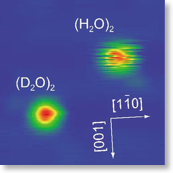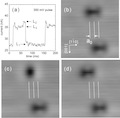Tunneling dynamics of a surface hydroxyl group
08/02/09 09:17 Filed in: single molecules, STM
Briefing of a recent publication: "Tunneling dynamics of a hydroxyl group adsorbed on Cu(110)", PRB 79, 035423 (2009).
 Structure and dynamics of a hydroxyl (OH) group on the Cu(110) surface is reported in this paper. The inclined OH axis of the hydroxyl group switches back and forth between the two equivalent orientations. Additionally, hydroxyl group is a basic system containing hydrogen. Hydrogen is the simplest element and shows quantum effects due to its low mass. Quantum tunneling of hydrogen atoms (or protons) plays crucial roles in diverse chemical, physical, and biological process. In this work, we investigated the dynamics of hydroxyl spices, including tunneling effect of hydrogen bound by double minimum potential well, as shown in the right figure.
Structure and dynamics of a hydroxyl (OH) group on the Cu(110) surface is reported in this paper. The inclined OH axis of the hydroxyl group switches back and forth between the two equivalent orientations. Additionally, hydroxyl group is a basic system containing hydrogen. Hydrogen is the simplest element and shows quantum effects due to its low mass. Quantum tunneling of hydrogen atoms (or protons) plays crucial roles in diverse chemical, physical, and biological process. In this work, we investigated the dynamics of hydroxyl spices, including tunneling effect of hydrogen bound by double minimum potential well, as shown in the right figure.
Read more...
 Structure and dynamics of a hydroxyl (OH) group on the Cu(110) surface is reported in this paper. The inclined OH axis of the hydroxyl group switches back and forth between the two equivalent orientations. Additionally, hydroxyl group is a basic system containing hydrogen. Hydrogen is the simplest element and shows quantum effects due to its low mass. Quantum tunneling of hydrogen atoms (or protons) plays crucial roles in diverse chemical, physical, and biological process. In this work, we investigated the dynamics of hydroxyl spices, including tunneling effect of hydrogen bound by double minimum potential well, as shown in the right figure.
Structure and dynamics of a hydroxyl (OH) group on the Cu(110) surface is reported in this paper. The inclined OH axis of the hydroxyl group switches back and forth between the two equivalent orientations. Additionally, hydroxyl group is a basic system containing hydrogen. Hydrogen is the simplest element and shows quantum effects due to its low mass. Quantum tunneling of hydrogen atoms (or protons) plays crucial roles in diverse chemical, physical, and biological process. In this work, we investigated the dynamics of hydroxyl spices, including tunneling effect of hydrogen bound by double minimum potential well, as shown in the right figure.Read more...
Water: monomers and dimers
06/01/09 11:50 Filed in: single molecules, STM
 Briefing of a recent publication:
Briefing of a recent publication:"Water mononer and dimer on Cu(110) studied using a scanning tunneling microscope"
T. Kumagai, M. Kaizu, H. Okuyama, S. Hatta, T. Aruga, I. Hamada, and Y. Morikawa, e-J. Surf. Sci. Nanotech. 6, 296-300 (2008).
Read more...
Toying with molecules
08/08/08 08:08 Filed in: single molecules | STM
Quantum dynamics of hydrogen bonds
01/04/08 12:00 Filed in: single molecules
 Water molecules are bound each other by hydrogen bond. In liquid water, three-dimensional networks of water moledules, formed by hydrogen bond, are rapidly changing their structure by incessant annihiration and re-creation of hydrogen bonds. It is believed that the chemical reaction in aqueous solution including those in vivo are influenced by the hydrogen bond.
Water molecules are bound each other by hydrogen bond. In liquid water, three-dimensional networks of water moledules, formed by hydrogen bond, are rapidly changing their structure by incessant annihiration and re-creation of hydrogen bonds. It is believed that the chemical reaction in aqueous solution including those in vivo are influenced by the hydrogen bond. Kumagai and Okuyama in our group succeeded in observing in real space the dynamics of hydrogen-bond alteration in water-dimer clusters isolated on a metal surface. They even revealed how the hydrogen bond alteration is governed by quantum mechanical tunneling effect....
Read more...
A new member of Peierls transition
01/04/08 11:08 Filed in: phase transitions
Peierls transition refers to the phenomena in which metals undergo phase changes associated with Fermi surface instability and periodic lattice distortion due to the interaction of electrons and phonons at
k = 2k_F. R. E. Peierls proposed the mechanism in his famous Quantum Theory of Solids (1955) in order to elucidate why low-symmetry structures are stabilized in crystalline Sb and Bi. Later, phase transitions found in 1970s in materials with low-dimensional Fermi surfaces have shown to be driven by this mechanism.
Owing to intensive studies, it has been established that the qualitative behaviour of the Peierls transition is well characterized by the strength of electron-phonon coupling as a dominant parameter. Thus the transitions are more often categorised simply into two classes: weak-coupling and strong-coupling types.
Our study have shown that the classification scheme is not appropreate...
Read more...







